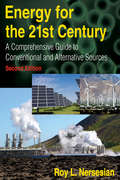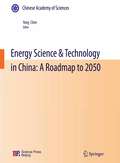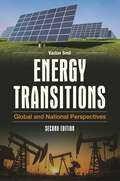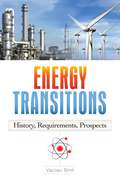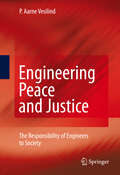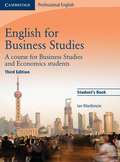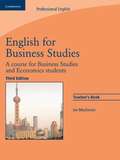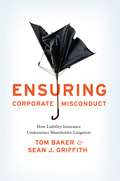- Table View
- List View
Enduring Success: What We Can Learn from the History of Outstanding Corporations
by Christian StadlerEnduring Success addresses a key question in business today: How can companies succeed over time? To learn the source of enduring greatness, author Christian Stadler directed a team of eight researchers in a six-year study of some of Europe's oldest and most stellar companies, targeting nine that have survived for more than 100 years and have significantly outperformed the market over the past fifty years. Readers may wonder, "Why European companies?" Yet, Europe is the ideal place to seek the key to long-term success; half of the Fortune Global 500 companies that are 100 years old or older can be found in Europe, as can 72 of the 100 oldest family businesses in the world. Fifteen years after Collins and Porras' Built to Last, this new book incorporates fresh insights from management science and provides the first non-US perspective on long-range success. Through Stadler's study, a counterintuitive story emerges: the greatest companies adapt to a constantly changing environment by being intelligently conservative. Enduring Success provides a coherent framework, grounded in five principles and practical concepts, for business leaders who are prepared to learn from the history of some of the world's greatest institutions. View the author's YouTube channel for more discussion of the book.
Energietechnik: Systeme zur Energieumwandlung. Kompaktwissen für Studium und Beruf
by Hans-Josef Allelein Elmar Bollin Helmut Oehler Udo Schelling Richard ZahoranskyDas Buch umfasst die gesamte Palette der Energietechnik, angefangen bei den Grundlagen der Energie-Verfahrenstechnik über die Beschreibung ausgeführter aktueller Anlagen (alle Kraftwerkstypen) bis zur Energieverteilung und -speicherung. Schwerpunkte sind regenerative/nachhaltige Energietechniken, Kombianlagen (z. B. Gas- und Dampfturbinen-Kraftwerke) und Anlagen mit Kraft-Wärme-Kopplung (z. B. BHKW). In der aktuellen Auflage wurden neue Trends in der Energietechnik eingearbeitet. Das Kapitel Windkraftanlagen wurde um Off-Shore-Anlagen ergänzt. Das Kapitel Kernenergie wurde überarbeitet und erhielt den neuen Schwerpunkt Reaktorsicherheit.
Energiewirtschaft in Europa: Im Spannungsfeld zwischen Klimapolitik, Wettbewerb und Versorgungssicherheit
by Friederike Anna Dratwa Bjö Spiegel Malko Ebers Anna Kristina Pohl Gunnar StrauchDer Klimawandel und der weltweit steigende Energiebedarf machen einen Umbau der europäischen Wirtschaft unumgänglich. Die Lösung der Energiefrage ist damit vielleicht die wichtigste Herausforderung unseres Jahrhunderts. Die Beiträge des Buchs setzen sich mit aktuellen Fragen des europäischen Energiesektors auseinander. Dabei eröffnet die Verbindung juristischer, wirtschaftlicher und politikwissenschaftlicher Ansätze eine multidimensionale Perspektive. Ein besonderer Fokus liegt auf Fragen der Energieversorgungssicherheit und des Wettbewerbsrechts.
Energise: How to survive and prosper in the age of scarcity
by Eddie HobbsEddie Hobbs has never been one to shy away from a challenge and his advice is that you shouldn't either! When the oil that we depend reaches scary prices, our lives are going to change utterly. This is going to happen much sooner than most of us want to admit and if we do not prepare for it, it's going to hit us where it hurts most: in our pockets.For years, Eddie Hobbs has been encouraging and supporting Irish people in getting to grips with our finances and now, in Energise, he gives us the tools to get to grips with the coming energy crisis and age of high inflation.In Energise he explains what you can do to prepare. You'll learn a range of strategies for managing your money so that wherever you are on the financial ladder - whether just waking up to the reality that you must take control of your finances, or wondering how your savings, pensions and investments are going to fare when the price of oil sky-rockets - you can survive and prosper during this age of high inflation. You'll also learn what Ireland needs to do to get ready for the energy crisis and what you can do to help raise public and political awareness.Eddie shows how, by taking control of your response to the new world order, you can prosper in unforeseen new ways. Energise is the essential starting point for getting to grips with the imminent age of scarcity.
Energy, Environment and Development
by Jose Goldemberg Oswaldo LuconThe relationship between energy and the environment has been the basis of many studies over the years, as has the relationship between energy and development, yet both of these approaches may produce distortions. In the first edition of this book, Professor Goldemberg pioneered the study of all three elements in relation to one another. With contributions from Oswaldo Lucon, this second edition has been expanded and updated to cover how energy is related to the major challenges of sustainability faced by the world today. The book starts by conceptualizing energy, and then relates it to human activities, to existing natural resources and to development indicators. It then covers the main environmental problems, their causes and possible solutions. Disaggregating national populations by income and by how different income groups consume energy, the authors identify the differences between local, regional and global environmental impacts, and can thus ascertain who is responsible for them. Finally, they discuss general and specific policies to promote sustainable development in energy. New coverage is included of today's pressing issues, including security, environmental impact assessment and future climate change/renewable energy regimes. The authors also cover all major new international agreements and technological developments. Energy, Environment and Development is the result of many years of study and practical experience in policy formulation, discussion and implementation in these fields by the authors. Written in a technical yet accessible style, the book is aimed at students on a range of courses, as well as non-energy specialists who desire an overview of recent thought in the area.
Energy, Environment and Development
by Jose Goldemberg Oswaldo LuconThe relationship between energy and the environment has been the basis of many studies over the years, as has the relationship between energy and development, yet both of these approaches may produce distortions. In the first edition of this book, Professor Goldemberg pioneered the study of all three elements in relation to one another. With contributions from Oswaldo Lucon, this second edition has been expanded and updated to cover how energy is related to the major challenges of sustainability faced by the world today. The book starts by conceptualizing energy, and then relates it to human activities, to existing natural resources and to development indicators. It then covers the main environmental problems, their causes and possible solutions. Disaggregating national populations by income and by how different income groups consume energy, the authors identify the differences between local, regional and global environmental impacts, and can thus ascertain who is responsible for them. Finally, they discuss general and specific policies to promote sustainable development in energy. New coverage is included of today's pressing issues, including security, environmental impact assessment and future climate change/renewable energy regimes. The authors also cover all major new international agreements and technological developments. Energy, Environment and Development is the result of many years of study and practical experience in policy formulation, discussion and implementation in these fields by the authors. Written in a technical yet accessible style, the book is aimed at students on a range of courses, as well as non-energy specialists who desire an overview of recent thought in the area.
Energy for the 21st Century: A Comprehensive Guide to Conventional and Alternative Sources
by Roy NersesianA compendium of current knowledge about conventional and alternative sources of energy. It clarifies complex technical issues, enlivens history, and illuminates the policy dilemmas we face today. This revised edition includes new material on biofuels, an expanded section on sustainability and sustainable energy, and updated figures and tables throughout. There are also online instructor materials for those professors who adopt the book for classroom use.
Energy for the 21st Century: A Comprehensive Guide to Conventional and Alternative Sources
by Roy NersesianA compendium of current knowledge about conventional and alternative sources of energy. It clarifies complex technical issues, enlivens history, and illuminates the policy dilemmas we face today. This revised edition includes new material on biofuels, an expanded section on sustainability and sustainable energy, and updated figures and tables throughout. There are also online instructor materials for those professors who adopt the book for classroom use.
Energy, Natural Resources and Environmental Economics (Energy Systems)
by Endre Bjørndal Mette Bjørndal Panos M. M. Pardalos Mikael RönnqvistThis book consists of a collection of articles describing the emergingand integrated area of Energy,Natural Resourcesand EnvironmentalEconomics.A majority of the authors are researchers doing applied work in economics, nance, and management science and are based in the Nordic countries. These countries have a long tradition of managing natural resources. Many of the applications are therefore founded on such examples. The book contents are based on a workshop that took place during May 15–16, 2008 in Bergen, Norway. The aim of the workshop was to create a meeting place for researchers who are active in the area of Energy, Natural Resource, and En- ronmentalEconomics,andat the same time celebrate ProfessorKurtJorns ¨ ten’s60th birthday. Thebookis dividedintofourparts. The rst part considerspetroleumandnatural gas applications, taking up topics ranging from the management of incomes and reserves to market modeling and value chain optimization. The second and most extensive part studies applications from electricity markets, including analyses of market prices, risk management, various optimization problems, electricity market design, and regulation. The third part describes different applications in logistics and management of natural resources. Finally, the fourth part covers more general problems and methods arising within the area.
Energy Options Impact on Regional Security (NATO Science for Peace and Security Series C: Environmental Security)
by Frano Barbir Sergio UlgiatiEnergy appears to be a fundamental driving force of economic and political strategies as well as planetary stability. Energy-related issues such as (1) the availability of new energy sources and viable technologies, (2) the disparity in access to energy sources, (3) the role of energy in our societies (energy societal metabolism), (4) the energy support to the life of our cities (where about half of world population is going to live very soon), and (5) the energy demand for food security all over the world, are “hot” problems that humans will have to face within the framework of sustainability (ecologically sound production and consumption patterns associated with socially acce- able life styles), in terms of policies, technological development and economic processes. A coherent energy strategy is required, addressing both energy supply and demand, security of access, development problems, equity, market dynamics, by also taking into account the whole energy lifecycle including fuel production, transmission and distribution, energy conversion, and the impact on energy equipment manufacturers and the end-users of energy systems. Issues of energy efficiency and rebound effect must also be taken into proper account. In the short term, the aim should be to achieve higher energy efficiencies and increased supply from local energy sources, in particular renewable energy sources.
Energy Science & Technology in China: A Roadmap to 2050
by Yong ChenAs one of the eighteen field-specific reports comprising the comprehensive scope of the strategic general report of the Chinese Academy of Sciences, this sub-report addresses long-range planning for developing science and technology in the field of energy science. They each craft a roadmap for their sphere of development to 2050. In their entirety, the general and sub-group reports analyze the evolution and laws governing the development of science and technology, describe the decisive impact of science and technology on the modernization process, predict that the world is on the eve of an impending S&T revolution, and call for China to be fully prepared for this new round of S&T advancement. Based on the detailed study of the demands on S&T innovation in China's modernization, the reports draw a framework for eight basic and strategic systems of socio-economic development with the support of science and technology, work out China's S&T roadmaps for the relevant eight basic and strategic systems in line with China's reality, further detail S&T initiatives of strategic importance to China's modernization, and provide S&T decision-makers with comprehensive consultations for the development of S&T innovation consistent with China's reality. Supported by illustrations and tables of data, the reports provide researchers, government officials and entrepreneurs with guidance concerning research directions, the planning process, and investment. Founded in 1949, the Chinese Academy of Sciences is the nation's highest academic institution in natural sciences. Its major responsibilities are to conduct research in basic and technological sciences, to undertake nationwide integrated surveys on natural resources and ecological environment, to provide the country with scientific data and consultations for government's decision-making, to undertake government-assigned projects with regard to key S&T problems in the process of socio-economic development, to initiate personnel training, and to promote China's high-tech enterprises through its active engagement in these areas.
Energy Transitions: Global and National Perspectives
by Vaclav SmilThis book provides a detailed, global examination of energy transitions, supplying a long-term historical perspective, an up-to-date assessment of recent and near-term advances in energy production technology and implementation, and an explanation of why efforts to limit global warming and to shift away from fossil fuels have been gradual.Based on the best international and national statistical sources, the second edition of Energy Transitions: Global and National Perspectives supplies an in-depth evaluation of how economies and nations around the world are striving to move away from traditional energy sources, the unfolding decarbonization process, and problems with intermittent energies and national transition plans. It supplies readers with a clear introduction to the basic properties of energy systems and key concepts of their appraisal, puts energy transition patterns in long-term historical perspective, and looks at the energy transition in eight of the world's leading economies. The last chapters focus on the advances in the decarbonization of the global energy supply and consider how the energy transition will continue in the coming decades.This fully updated and substantially expanded edition addresses the many new developments affecting energy supply, such as the recent expansion of hydraulic fracturing, oil price fluctuations, the Fukushima nuclear power plant catastrophe, advances in solar and wind generation, adoption of combined cycle gas turbines, and increased availability of electric cars. The coverage highlights the differences in the pace of transitions in various countries, thereby providing a complete and accurate picture of the current state of energy development in different parts of the world. The book serves as an invaluable resource for students as well as for anyone interested in a realistic appraisal of the current state of energy transitions in various nations and regions and the likely future development of the global energy supply.
Energy Transitions: History, Requirements, Prospects
by Vaclav SmilThis bold and controversial argument shows why energy transitions are inherently complex and prolonged affairs, and how ignoring this fact raises unrealistic expectations that the United States and other global economies can be weaned quickly from a primary dependency on fossil fuels.Energy transitions are fundamental processes behind the evolution of human societies: they both drive and are driven by technical, economic, and social changes. In a bold and provocative argument, Energy Transitions: History, Requirements, Prospects describes the history of modern society's dependence on fossil fuels and the prospects for the transition to a nonfossil world. Vaclav Smil, who has published more on various aspects of energy than any working scientist, makes it clear that this transition will not be accomplished easily, and that it cannot be accomplished within the timetables established by the Obama administration.The book begins with a survey of the basic properties of modern energy systems. It then offers detailed explanations of universal patterns of energy transitions, the peculiarities of changing energy use in the world's leading economies, and the coming shifts from fossil fuels to renewable conversions. Specific cases of these transitions are analyzed for eight of the world's leading energy consumers. The author closes with perspectives on the nature and pace of the coming energy transition to renewable conversions.
Engineering Asset Management: Proceedings of the Fourth World Congress on Engineering Asset Management (WCEAM) 2009
by Dimitris Kiritsis Christos Emmanouilidis Andy Koronios Joseph MathewEngineering Asset Management discusses state-of-the-art trends and developments in the emerging field of engineering asset management as presented at the Fourth World Congress on Engineering Asset Management (WCEAM).It is an excellent reference for practitioners, researchers and students in the multidisciplinary field of asset management, covering such topics as asset condition monitoring and intelligent maintenance; asset data warehousing, data mining and fusion; asset performance and level-of-service models; design and life-cycle integrity of physical assets; deterioration and preservation models for assets; education and training in asset management; engineering standards in asset management; fault diagnosis and prognostics; financial analysis methods for physical assets; human dimensions in integrated asset management; information quality management; information systems and knowledge management; intelligent sensors and devices; maintenance strategies in asset management; optimisation decisions in asset management; risk management in asset management; strategic asset management; and sustainability in asset management.
Engineering Peace and Justice: The Responsibility of Engineers to Society
by P. Aarne VesilindSome years ago when I was chair of the department of civil and environmental engineering, a colleague introduced me to a visitor from Sandia Laboratories, perhaps the largest developer of armaments and weapons systems in the world. We had a nice visit, and as we chatted, the talk naturally centered on the visitor’s engineering work. It turned out that his job in recent years had been to develop a new acoustic triggering device for bombs. As he explained it, the problem with bombs was that the plunger triggering mechanism could fail if the bomb hit at an angle, and thus the explosives would not detonate. To get around this, he dev- oped an acoustic trigger that would detonate the explosives as soon as the bomb hit any solid surface, even at an angle. As he talked, I watched his face. His enthusiasm for his work was clearly e- dent, and his animated explanations of what they had developed at Sandia exuded pride and excitement. I thought about asking him what it felt like to have spent his engineering career designing better ways to kill people or to destroy property – the sole purpose of a bomb. I wondered how many people had been killed because this man had dev- oped a clever acoustic triggering device. But good sense and decorum prevailed and I did not ask him such questions. We parted as friends and in good spirits.
The Engineer's Career Guide
by John A. HoschetteThis is the most complete career resource guide book for engineers dealing with the non-technical side of engineering. It provides career advice for engineers at all stages of their careers, whether newly graduated, mid-career, or soon-to-be-retired. This book provides many real world, practical, proven, common sense career tips supported by actual work and experiences/examples. Tips deal with problems the engineer may encounter with supervisors, co-workers and others in the corporation. The book provides step-by-step guidance on how to deal with career problems and come out ahead.
English Catholics and the Education of the Poor, 1847–1902 (Perspectives in Economic and Social History)
by Eric G TenbusFilling an important gap in the historiography of Victorian Britain, this book examines the English Catholic Church's efforts during the second half of the nineteenth century to provide elementary education for Catholics.
English Catholics and the Education of the Poor, 1847–1902 (Perspectives in Economic and Social History #5)
by Eric G TenbusFilling an important gap in the historiography of Victorian Britain, this book examines the English Catholic Church's efforts during the second half of the nineteenth century to provide elementary education for Catholics.
English For Business Studies Student's Book: A Course For Business Studies And Economics Students (PDF)
by Ian MackenzieThis best selling course has been thoroughly revised to meet the needs of today's business and economics students. English for Business Studies Third Edition reflects recent changes in the world's business and economic environment, featuring new units including Corporate Social Responsibility and Venture Capital. Covering the most important areas of management, production, marketing, finance and macroeconomics, it helps students to understand and talk about key concepts in business and economics. Using case studies, discussions and role-plays, the course helps learners to develop and defend their own viewpoints, and new audio featuring authentic interviews with business people offers realistic listening practice.
English For Business Studies Teacher's Book: A Course For Business Studies And Economics Students (PDF)
by Ian MackenzieThis best selling course has been thoroughly revised to meet the needs of today's business and economics students. The English for Business Studies Third edition Teacher's Book offers thorough guidance and support for teachers using the course. It also includes four assessment tests to help teachers keep track of students' progress. The English for Business Studies Student's Book and the Audio CDs are available separately.
English, Irish and Subversives Among the Dismal Scientists (Research in the History of Economic Thought and Methodology #28, Part B)
by Marianne Johnson Jeff E. Biddle Ross B. Emmett Noel W. Thompson Nigel F. AllingtonThis volume presents commissioned essays on important, but often neglected, Irish and English economists of the 18th and 19th centuries. Noticeable papers include Tom Sowell on 'Observations on Certain Verbal Disputes' and Sam Hollander's extended essay on Samuel Bailey, which adds to his voluminous treatment of the great classical economists. This volume intends to bring much needed attention back onto forgotten economists that shaped economic history.
Enhancing Competences for Competitive Advantage (Advances in Applied Business Strategy #12)
by Aimé Heene Ron SanchezThis volume explores ways in which an organization's existing competences can be enhanced as sources of competitive advantage - either enduring or intendedly transitional. Competence enhancing activities considered include political lobbying to extend the lifetime and value of a firm's competences, expanding services to enhance the value of manufacturing capabilities, initiating knowledge management projects, strategically adapting a firm's governance structures to take advantage of government policy initiatives, staging development of competences in internationalization processes, improving capabilities in managing alliances, understanding the factors conducive to entrepreneurial action-taking, and using individual competency development in self-managing processes for organizational competence building.
Enough is Enough: How to Build a New Republic
by Fintan O'TooleThe Republic of Ireland, which declared itself in 1949, allowed the Catholic Church to dominate its civil society and education system. Investment by American and European companies, and a welcoming tax regime, created the 'Celtic Tiger' of the 1990s. That brief burst of good fortune was destroyed by a corrupt political class which encouraged a wild property boom, leaving the country almost bankrupt. What Ireland needs now is a programme of real change. It needs to become a fully modern republic in fact as well as name. This disastrous economic collapse also allows us to think through the kind of multiculturalism that Ireland needs, and to build institutions that can accommodate the sudden influx of migrants who have come to Ireland in the past 15 years. The State should take over the entire education system, for which it pays already, and make it fit for the 21st century. The political system is dysfunctional and is one of the main causes of the debacle we have just experienced. Ireland needs constitutional reform. Politicians have been let get away with murder, and there is a fatalistic sense that nothing can change. The country needs to encourage participation in, and oversight and knowledge of politics, to make people feel that they have a right to challenge the old party machines and to make a difference. It is their country, after all.
Ensuring Corporate Misconduct: How Liability Insurance Undermines Shareholder Litigation
by Tom Baker Sean J. GriffithShareholder litigation and class action suits play a key role in protecting investors and regulating big businesses. But Directors and Officers liability insurance shields corporations and their managers from the financial consequences of many illegal acts, as evidenced by the recent Enron scandal and many of last year’s corporate financial meltdowns. Ensuring Corporate Misconduct demonstrates for the first time how corporations use insurance to avoid responsibility for corporate misconduct, dangerously undermining the impact of securities laws. As Tom Baker and Sean J. Griffith demonstrate, this need not be the case. Opening up the formerly closed world of corporate insurance, the authors interviewed people from every part of the industry in order to show the different instances where insurance companies could step in and play a constructive role in strengthening corporate governance—yet currently do not. Ensuring Corporate Misconduct concludes with a set of readily implementable reforms that could significantly rehabilitate the system.
Ensuring Corporate Misconduct: How Liability Insurance Undermines Shareholder Litigation
by Tom Baker Sean J. GriffithShareholder litigation and class action suits play a key role in protecting investors and regulating big businesses. But Directors and Officers liability insurance shields corporations and their managers from the financial consequences of many illegal acts, as evidenced by the recent Enron scandal and many of last year’s corporate financial meltdowns. Ensuring Corporate Misconduct demonstrates for the first time how corporations use insurance to avoid responsibility for corporate misconduct, dangerously undermining the impact of securities laws. As Tom Baker and Sean J. Griffith demonstrate, this need not be the case. Opening up the formerly closed world of corporate insurance, the authors interviewed people from every part of the industry in order to show the different instances where insurance companies could step in and play a constructive role in strengthening corporate governance—yet currently do not. Ensuring Corporate Misconduct concludes with a set of readily implementable reforms that could significantly rehabilitate the system.





